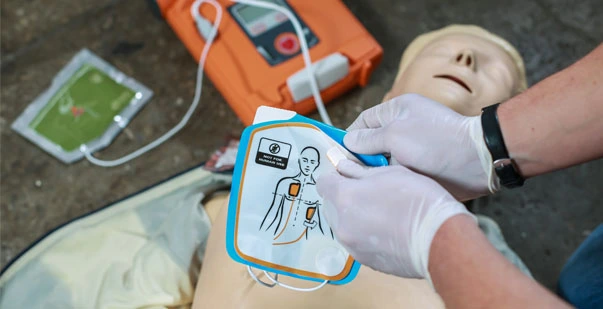
Last Updated On: septiembre 9, 2024
Cardiopulmonary resuscitation (CPR) and automated external defibrillator (AED) improve patient recovery during a cardiac emergency. In a notable study, the chances of survival are higher after using CPR or AED independently. This highlights the vital role of combining CPR and AED training, ensuring a speedy intervention towards cardiac emergencies. Learn when to use AED and explore when CPR and AED are used together.
AED is a user-friendly and portable device that administers an electric shock during a sudden cardiac arrest (SCA). AEDs have a simple interface with audio and graphical directives. Advanced AEDs contain a built-in assessment mechanism wherein a user receives feedback about the quality of their CPR actions, like depth and rates of compression.
CPR stands for Cardiopulmonary Resuscitation. Although CPR itself involves compressions on the chest and rescue breaths, its effectiveness mostly results from maintaining the proper frequency of the compressions. Recent research focuses on the psychological component of CPR, stressing that response providers must have confidence and clarity when intervening since this influences the effectiveness of interventions.
Automated external defibrillator (AED) and cardiopulmonary resuscitation (CPR) comprise different but similar functional elements. Here are the primary differences between AED and CPR:
To ascertain the time for using CPR and AED, you need to evaluate how responsive the individual is. When one is unconscious or is not breathing normally, then promptly give first aid that involves chest compressions and rescue breaths. At the same time, somebody would retrieve an AED and begin using it immediately. An AED will analyze the heart rhythm and provide an electric shock when necessary.
Read More: https://cprcare.com/how-to-get-cpr-certified-for-free-with-aed-training/
Emergency management of cardiac arrest increases the patients’ likelihood of survival by integrating automated external defibrillators (AEDs) into CPR.
These two life-saving interventions help achieve maximum efficiency in critical scenarios. Here are its benefits:
Q: Can you use an AED and CPR together?
A: When to use AED vs CPR? An AED and CPR can and should go together in a case of cardiac arrest. During CPR, chest compressions continue with an AED. AED will then analyze the heart rhythm and administer a shock upon necessity; these should run simultaneously with chest compressions, improving the survival rate after cardiac arrest.
Q: Do you stop CPR to apply for AED?
A: No, it is the AED who stops the CPR while you are inserting the pads in the patient’s chest. The person should retrieve and use the AED while the CPR is being performed, providing an uninterrupted flow of the CPR circuit and sustaining the blood supply until further diagnosis.
Q: Why is AED used during CPR?
A: During CPR, an AED analyzes the heart rhythm and gives the patient a shock when required to reestablish a normal heart rhythm. This increases its effectiveness, increasing the effect of CPR.
Thus, yes, if you are wondering should CPR and AED be used together, the answer is yes. AED is also key because a combined effort always leads to better results, thus instilling courage among people. CPR and AED are used together and boosts survival chances Through the combined use of these interventions, they holistically address resuscitation.